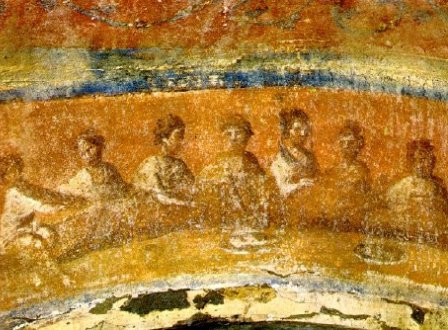|

|
The Rule of Faith |
|
Part I
“The teaching is a kind of building: if we do not bind the house
together by regular bonds in the building, lest some gap be found, and the
building become unsound, even our former labor is of no use. But stone
must follow stone by course, and corner match with corner, and by our
smoothing off inequalities the building must thus rise evenly. In like
manner we are bringing to you stones, as it were of knowledge. You must
hear concerning the living God, you must hear of Judgment, must hear of
Christ, and of the Resurrection. And many things there are to be discussed
in succession, which though now dropped one by one are afterwards to be
presented in harmonious connection. But unless you fit them together in
the one whole, and remember what is first, and what is second, the builder
may build but you will find the building unsound”
--Cyril
of
Jerusalem, Prologue to Catechetical Lectures
Themes
to Track
- Tradition
as an opposition tool to heresy
- Tradition
as a guarantee of biblical interpretation
- Apostolicity
as the right to interpret Scripture
- Apostolicity
as a mark of catholicity
- The
Preaching of the apostles (kergyma);
key elements in summaries of the faith
- Liturgy
and the content of the faith
- Proto-creedal
statements
- Materials
for instruction of new believers (catechism)
- Incorporation
of the New Testament into instructions in the faith
General
Overview Questions
- What
is the relationship of Christian tradition to the Christian
scriptures?
- How
do we guarantee a biblical interpretation is true?
- Can
we summarize the preaching of the gospel? Why or why not?
- Are
statements of faith necessary? What legitimate role should they play?
- Are
such statements binding on a church, its members, or its organizations
(e.g. a Christian university)?
- What
purpose do such statements play in instruction for the faith?
- What
place does public worship play in passing along the faith, esp.
doctrine?
|
| Part
II
“The
history of New Testament interpretation strongly suggests that the New
Testament under-determines its own interpretation; it seems foolish even
for a Christian believer to claim that an honest, reasonable interpreter
of the New Testament would necessarily arrive at readings consistent with
Christian orthodoxy, if the interpretative process proceeded
independently of the Church and the Holy Spirit.”
--Stephen Davis, “Tradition, Scripture, and Religious Authority”
Themes to Track
-
The order of the
elements in the Rule
-
The Trinitarian
structure
-
What is basic to the
tradition and what is left open
-
How the Rule/Symbol
impacts the believer
-
The relationship of
scripture and tradition
-
The definitions for
universality, antiquity, and consent
-
Use of the Rule in
catechism and baptism
-
Creeds as a way of
explaining the Faith
Three
General Questions (C. Stephen
Evans)
-
Is there such a thing
as the Rule of Faith?
-
Is interpreting by the
Rule of Faith consistent with sola scriptura?
-
Is interpretation by
the Rule of Faith viciously circular?
Observations on
Patristic Relationship Between Scripture and Tradition
-
The Rule of Faith is
the interpretive schema by which scripture is rightly understood.
-
Scripture and the Rule
work together in tandem.
-
Tradition is not seen
as an extra authority equal to scripture, nor is it revelation
functioning separately from scripture.
-
The scriptures are the
sources for the creedal language.
-
The scriptures are
infallible because of God’s divine intentions.
-
The Rule functions as
a ratio (scope) of what may be believed.
-
The Bible serves
within the life of teaching and worship as a collective treasure held
by all.
-
For most patristic
Christians, Scripture was heard and taught in public settings.
-
The Holy Spirit works
within the Church’s tradition and within scripture to guide souls to
a greater love for God.
-
Scripture can only be
understood within a godly community led by those of high character and
orthodox faith.
-
Scripture has a
mystical nature—a literal sense, an ethical sense, and a mysterious
(allegorical) one—because it is Holy Spirit-inspired.
-
The Bible brings the
Christian into the deep life, and in turn, the spiritually mature can
discern the deeper truths of scripture.
quod ubique, quod semper, quod ab
omnibus creditum est
("to that which is believed everywhere, always, and by all") |
|
